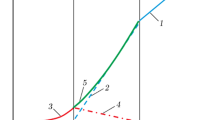Abstract
A comprehensive ignition model for single boron particles in an oxygenated environment containing O2 and H2O is developed. Microcharacteristics of the boron oxide layer on the surface of boron particles at elevated temperatures are studied. Two typical distributions of species inside the surface oxide layer are detected. One is composed of three layers [B2O3, (BO) n , and B2O3], while the other is composed of two layers [(BO) n and B2O3], both according to the order from the internal to external side of the layer. In the model development, two submodels, submodel I and submodel II, are developed with regard to two different observed species distributions in the surface oxide layer. For submodel I, it is assumed that both (BO) n and O2 are the governing species diffusing into the liquid oxide layer. For submodel II, only (BO) n is the governing species. These two submodels are combined into a new bi-directional model consisting of four key kinetic processes: evaporation of the liquid oxide layer, global surface reaction between oxygen from the environment and boron, reaction between the inner boron core and oxygen, and global reaction of boron with water vapor. The ignition time predicted by the model is in good agreement with previous experimental data.
Similar content being viewed by others
References
B. V. Devener, J. P. L. Perez, J. Jankovich, and S. L. Anderson, “Oxide-Free, Catalyst-Coated, Fuel-Soluble, Air-Stable Boron Nanopowder as Combined Combustion Catalyst and High Energy Density Fuel,” Energy Fuels 23, 6111–6120 (2009).
B. Hussmann and M. Pfitzner, “Extended Combustion Model for Single Boron Particles. Part I: Theory,” Combust. Flame 157(4), 803–821 (2010).
B. Hussmann and M. Pfitzner, “Extended Combustion Model for Single Boron Particles. Part II: Validation,” Combust. Flame 157(4), 822–833 (2010).
G. Young, K. Sullivan, M. R. Zachariah, and K. Yu, “Combustion Characteristics of Boron Nanoparticles,” Combust. Flame 156(2), 322–333 (2009).
A. Ulas, K. K. Kuo, and C. Gotzmer, “Effects of Fluorine-Containing Species on the Ignition and Combustion of Boron Particles: Experiment and Theory,” Combust. Energ. Mater. 453–463 (2002).
M. K. King, “Boron Particle Ignition in Hot Gas Streams,” Combust. Sci. Technol. 8(5/6), 255–273 (1974).
M. K. King, “Ignition and Combustion of Boron Particles and Clouds,” J. Spacecraft Rockets 19(4), 294–306 (1982).
C. L. Yeh and K. K. Kuo, “Ignition and Combustion of Boron Particles,” Prog. Energy Combust. Sci. 22(6), 511–541 (1996).
W. Zhou, R. A. Yetter, F. Dryer, et al., “Multi-Phase Model for Ignition and Combustion of Boron Particles,” Combust. Flame 117(1–2), 227–243 (1999).
M. K. King, “Boron Ignition and Combustion in Air-Augmented Rocket Afterburners,” Combust. Sci. Technol. 5(4), 155–164 (1972).
D. Meinkohn, “The Ignition of Boron Particles,” Combust. Flame 59(3), 225–232 (1985).
A. Macek and J. Semple, “Combustion of Boron Particles at Atmospheric Pressure,” Combust. Sci. Technol. 1(3), 181–191 (1969).
R. A. Meese and J. G. Skifstad, “Ignition and Global Combustion Models for Clouds of Boron Particles,” AIAA J. 12(1), 71–77 (1974).
L. A. Gaponenko, S. N. Buinovskii, Yu. I. Tulupov, and T. A. Yakovleva, “A Model for the Ignition of a Single Boron Particle in a Medium Containing Water,” Fiz. Goreniya Vzryva 17(1), 13–19 (1981) [Combust., Explos., Shock Waves 17 (1), 9–13 (1981)].
G. Mohan and F. A. Williams, “Ignition and Combustion of Boron in O2-Inert Atmospheres,” AIAA J. 10(6), 776–783 (1972).
C. P. Talley and U. V. Henderson, “Combustion of Elemental Boron,” in Proc. 4th Meeting JANAF-ARPA-NASA Thermochemical Panel, 1961, p. 107.
I. Glassman, F. A. Williams, and P. Antaki, “A Physical and Chemical Interpretation of Boron Particle Combustion,” in Proc. 20th Symp. (Int.) on Combustion (Ann Arbor, Mich., 1984), pp. 2057–2064.
S. C. Li and F. A. Williams, “Ignition and Combustion of Boron in Wet and Dry Atmospheres,” in Proc. 23rd Symp. (Int.) on Combustion (Orleans, France, 1990), pp. 1147–1154.
C. L. Yeh, K. K. Kuo, and M. Klimkiewicz, “Environmental Scanning Electron Microscopy Studies of Diffusion Mechanism of Boron Particle Combustion,” Scanning 19(2), 114–118 (1997).
A. Ulas, K. K. Kuo, and C. Gotzmer, “Ignition and Combustion of Boron Particles in Fluorine-Containing Environments,” Combust. Flame 127(1/2), 1935–1957 (2001).
Author information
Authors and Affiliations
Corresponding author
Additional information
Original Russian Text © W. Ao, J.H. Zhou, J.Z. Liu, W.J. Yang, Y. Wang, H.P. Li.
__________
Translated from Fizika Goreniya i Vzryva, Vol. 50, No. 3, pp. 21–31, May–June, 2014.
Rights and permissions
About this article
Cite this article
Ao, W., Zhou, J.H., Liu, J.Z. et al. Kinetic model of single boron particle ignition based upon both oxygen and (BO) n diffusion mechanism. Combust Explos Shock Waves 50, 262–271 (2014). https://doi.org/10.1134/S0010508214030034
Received:
Revised:
Published:
Issue Date:
DOI: https://doi.org/10.1134/S0010508214030034




